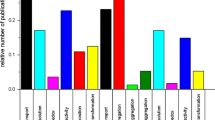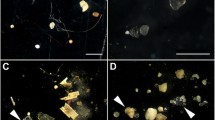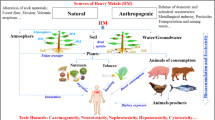Abstract
Tenax extraction, a measure of chemical desorption rates from sediments, was used to evaluate the bioaccessibility of bifenthrin in two different sediments exposed to three temperatures aged over a 56-d holding period. A 24-h single-point Tenax extraction was used and parent 14C-bifenthrin and polar metabolites were quantified in the sediment and Tenax. Bioaccessibility of bifenthrin was inversely related to the organic carbon (OC) content in the sediment, holding time, and temperature. Sequestration of the bifenthrin into slowly desorbing fractions within the sediment appears to have decreased degradation of the parent compound into metabolites and decreased the amount of parent compound bioaccessible for uptake by the Tenax. These results suggest that the environmental risk of bifenthrin to aquatic species is greatest immediately after the pesticide enters a waterbody after runoff, for low-OC content sediments, and in areas or seasons where water temperatures are colder.


Similar content being viewed by others
Data Availability
Data will be available on request to the corresponding author and will be published on OpenSIUC which is an open-access institutional repository at SIU.
References
Amweg EL, Weston DP, You J, Lydy MJ (2006) Pyrethroid insecticides and sediment toxicity in urban creeks from California and Tennessee, USA. Environ Sci Technol 40:1700–1706
Buonaccorsi JP, Liebhold AM (1988) Statistical methods for estimating ratios and products in ecological studies. Environ Entomol 17:572–580
Coats JR, Symonik DM, Bradbury SP, Dyer SD, Timson LK, Atchison GJ (1989) Toxicology of synthetic pyrethroids in aquatic systems: An overview. Environ Tox Chem 8:671–680
de Perre C, Trimble AJ, Maul JD, Lydy MJ (2014) Ecological bioavailability of permethrin and p, p′-DDT: Toxicity depends on type of organic matter resource. Chemosphere 96:67–73
Delle Site A (2001) Factors affecting sorption of organic compounds in natural sorbent/water systems and sorption coefficients for selected pollutants a review. J Phy Chem Ref Data 30(1):187–439
Edler R (2015) Available Quench Parameters in TriCarb LSC’s. Perkin Elmer, Application Note
USEPA (2002) Short-term methods for estimating the chronic toxicity of effluents and receiving waters to freshwater organisms. EPA-821-R-02-013. US Environmental Protection Agency, Washington, DC, USA, p 335
Feo ML, Corcellas C, Barata C, Ginebreda A, Eljarrat E, Barceló D (2013) Organic carbon content effects on bioavailability of pyrethroid insecticides and validation of solid phase extraction with Poly (2,6-diphenyl-p-phenylene oxide) Polymer by Daphnia magna toxicity tests. Sci Total Environ 442:497–502
Gan J, Lee SJ, Liu WP, Haver D, Kabashima JN (2005) Distribution and persistence of pyrethroids in runoff sediments. J Environ Qual 34:836–841
Hall LW Jr, Anderson RD (2020) An eighteen-year temporal trends analysis of bifenthrin sediment concentrations in California waterbodies. Water 12(9):2402
Harris D (2010) Quantitative Chemical Analysis, 8th edn. W.H. Freeman and Company, New York, pp 103–105
Harwood AD, Landrum PF, Lydy MJ (2012) Can SPME fiber and Tenax methods predict the bioavailability of biotransformed insecticides? Environ Sci Tech 46:2413–2419
Harwood AD, Nutile SA, Landrum PF, Lydy MJ (2015) Tenax extraction as a simple approach to improve environmental risk assessments. Environ Tox Chem 34(7):1445–1453
Huff Hartz KE, Sinche FL, Nutile SA, Fung CY, Moran PW, Van Metre PC, Nowell LH, Mills M, Lydy MJ (2018) Effect of sample holding time on bioaccessibility and sediment ecotoxicological assessments. Environ Poll 242:2078–2087
Laskowski, DA (2002) Physical and chemical properties of pyrethroids. Rev Environ Contam Tox: Contin Res Rev, pp 49–170
Lydy MJ, Harwood AD, Nutile SA, Landrum PF (2015) Tenax extraction of sediments to estimate desorption and bioavailability of hydrophobic contaminants: A literature review. Int Environ Assess Man 11:208–220
Magnuson JT, Huff Hartz KE, Fulton CA, Lydy MJ, Schlenk D (2021) Transcriptomic and histopathological effects of bifenthrin to the brain of juvenile Rainbow Trout (Oncorhynchus mykiss). Toxics 9(3):48
Nutile SA, Harwood AD, Sinche FL, Huff Hartz KE, Landrum PF, Lydy MJ (2017) Methodological and environmental impacts on bioaccessibility estimates provided by single-point Tenax extractions. Arch Environ Contam Tox 72:612–621
Pehkonen S, You J, Akkanen J, Kukkonen JV, Lydy MJ (2010) Influence of black carbon and chemical planarity on bioavailability of sediment-associated contaminants. Environ Tox Chem 29(9):1976–1983
Pignatello J, Xing B (1996) Mechanisms of slow sorption of organic chemicals to natural particles. Environ Sci Tech 30:1–11
Sinche F, Nutile S, Huff Hartz KE, Landrum PF, Lydy MJ (2018) Effects of type and quantity of organic carbon on the bioaccessibility of polychlorinated biphenyls in contaminated sediments. Environ Tox Chem 37(5):1280–1290
Trimble TA, You J, Lydy MJ (2008) Bioavailability of PCBs from field-collected sediments: Application of Tenax extraction and matrix-SPME techniques. Chemosphere 71(2):337–344
Weston DP, Lydy MJ (2010) Urban and agricultural sources of pyrethroid insecticides to the Sacramento-San Joaquin Delta of California. Environ Sci Tech 44(5):1833–1840
Weston DP, Holmes RN, You J, Lydy MJ (2005) Aquatic toxicity due to residential use of pyrethroid insecticides. Environ Sci Tech 39:9778–9784
Weston DP, You J, Harwood AD, Lydy MJ (2009) Whole sediment toxicity identification evaluation tools for pyrethroid insecticides: III Temperature manipulation. Environ Tox Chem: An Intern J 28(1):173–180
Weston DP, Asbell AM, Hecht SA, Scholz NL, Lydy MJ (2011) Pyrethroid insecticides in urban salmon streams of the Pacific Northwest. Environ Poll 159(10):3051–3056
Xu Y, Gan J, Wang Z, Spurlock F (2008) Effect of aging on desorption kinetics of sediment-associated pyrethroids. Environ Tox Chem 27:1293–1301
Yang Y, Wu N, Wang C (2018) Toxicity of the pyrethroid bifenthrin insecticide. Environ Chem Lett 16:1377–1391
You J, Pehkonen S, Landrum PF, Lydy MJ (2007) Desorption of hydrophobic compounds from laboratory-spiked sediments measured by Tenax absorbent and matrix solid-phase microextraction. Environ Sci Tech 41(16):5672–5678
You J, Pehkonen S, Weston DP, Lydy MJ (2008) Chemical availability and sediment toxicity of pyrethroid insecticides to Hyalella azteca: Application to field sediment with unexpectedly low toxicity. Environ Tox Chem 27:2124–2130
You J, Brennan AA, Lydy MJ (2009) Bioavailability and biotransformation of sediment-associated pyrethroid insecticides in Lumbriculus variegatus. Chemosphere 75:1477–1482
Zhang Q, Wang H, Xia X, Bi S, Lin H, Chen J (2020) Elevated temperature enhances the bioavailability of pyrene to Daphnia magna in the presence of dissolved organic matter: Implications for the effect of climate warming. Environ Poll 266(2):115349
Acknowledgements
The authors would like to thank R. Petzold, N. Gamble, and K. Huff Hartz for assistance with experiments.
Funding
This research was supported by research support provided by Southern Illinois University to M.J. Lydy.
Author information
Authors and Affiliations
Corresponding author
Ethics declarations
Conflict of interest
The authors declare that they have no known competing financial interests or personal relationships that could have appeared to influence the work reported in this paper.
Rights and permissions
Springer Nature or its licensor (e.g. a society or other partner) holds exclusive rights to this article under a publishing agreement with the author(s) or other rightsholder(s); author self-archiving of the accepted manuscript version of this article is solely governed by the terms of such publishing agreement and applicable law.
About this article
Cite this article
Arkles, M., Sinche, F. & Lydy, M.J. Assessing the Influence of Organic Carbon, Aging Time and Temperature on Bioaccessibility of Bifenthrin. Arch Environ Contam Toxicol 85, 429–437 (2023). https://doi.org/10.1007/s00244-023-01039-5
Received:
Accepted:
Published:
Issue Date:
DOI: https://doi.org/10.1007/s00244-023-01039-5




